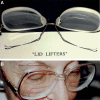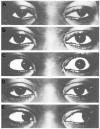Treatment of strabismus and blepharospasm with Botox (onabotulinumtoxinA): Development, insights, and impact
- PMID: 37499080
- PMCID: PMC10374181
- DOI: 10.1097/MD.0000000000032374
Treatment of strabismus and blepharospasm with Botox (onabotulinumtoxinA): Development, insights, and impact
Abstract
Strabismus, deviation of the ocular alignment, can adversely affect quality of life and activities of daily living. Surgery was the prior standard of care for strabismus, but up to 40% of patients required additional surgeries. This need for more effective and less invasive treatment, along with the convergence of other events such as the development of electromyography, purification of botulinum toxin A, and the finding that injection of botulinum toxin type A could paralyze the hind limbs of chicks, led Dr. Alan Scott to investigate injection of his formulation for strabismus. The positive results of initial trials in monkeys segued to human trials with observations of alignment improvements and few adverse events. The success of botulinum toxin type A in the treatment of strabismus led to interest in its use to treat other skeletal muscles, particularly in blepharospasm, a type of focal dystonia involving eyelid spasms and involuntary eye closure that lacked an effective pharmacological treatment. Patient groups helped to increase awareness of this novel treatment, and results from clinical trials confirmed its effectiveness. Dr. Scott's formulation, then known as Oculinum, received its first Food and Drug Administration approvals in 1989 for strabismus and blepharospasm. Allergan acquired Oculinum in 1991, renaming it Botox. These initial uses led to its application in a myriad of other indications as outlined in other articles of this supplement.
Copyright © 2023 the Author(s). Published by Wolters Kluwer Health, Inc.
Figures





Similar articles
-
Early development history of Botox (onabotulinumtoxinA).Medicine (Baltimore). 2023 Jul 1;102(S1):e32371. doi: 10.1097/MD.0000000000032371. Medicine (Baltimore). 2023. PMID: 37499077 Free PMC article.
-
[Use of botulinum toxin in ophthalmology].Klin Monbl Augenheilkd. 1986 Feb;188(2):89-94. doi: 10.1055/s-2008-1050585. Klin Monbl Augenheilkd. 1986. PMID: 3713087 German.
-
Review of the FDA-approved uses of botulinum toxins, including data suggesting efficacy in pain reduction.Clin J Pain. 2002 Nov-Dec;18(6 Suppl):S142-6. doi: 10.1097/00002508-200211001-00005. Clin J Pain. 2002. PMID: 12569961 Review.
-
Application of botulinum toxin to clinical therapy: advances and cautions.Am J Ther. 2012 Jul;19(4):281-6. doi: 10.1097/MJT.0b013e3181e9b655. Am J Ther. 2012. PMID: 22481607
-
Botulinum toxin in blepharospasm and oromandibular dystonia: comparing different botulinum toxin preparations.Eur J Neurol. 2006 Feb;13 Suppl 1:21-9. doi: 10.1111/j.1468-1331.2006.01441.x. Eur J Neurol. 2006. PMID: 16417594 Review.
Cited by
-
Diplopia Secondary to Neurotoxin Injections: Prevention, Diagnosis, and Management.J Clin Aesthet Dermatol. 2024 Mar;17(3-4 Suppl 1):S30-S36. J Clin Aesthet Dermatol. 2024. PMID: 38601787 Free PMC article. Review. No abstract available.
-
The pluripotential evolution and journey of Botox (onabotulinumtoxinA).Medicine (Baltimore). 2023 Jul 1;102(S1):e32373. doi: 10.1097/MD.0000000000032373. Medicine (Baltimore). 2023. PMID: 37499079 Free PMC article. Review.
-
Botulinum Neurotoxins as Two-Faced Janus Proteins.Biomedicines. 2025 Feb 8;13(2):411. doi: 10.3390/biomedicines13020411. Biomedicines. 2025. PMID: 40002825 Free PMC article. Review.
-
Exploring New and Potential Indications for Botulinum Toxin Treatment: An Updated Literature Review.Cureus. 2024 Dec 11;16(12):e75549. doi: 10.7759/cureus.75549. eCollection 2024 Dec. Cureus. 2024. PMID: 39803022 Free PMC article. Review.
-
From Toxin to Treatment: A Narrative Review on the Use of Botulinum Toxin for Autonomic Dysfunction.Toxins (Basel). 2024 Feb 10;16(2):96. doi: 10.3390/toxins16020096. Toxins (Basel). 2024. PMID: 38393175 Free PMC article. Review.
References
-
- Rutstein RP, Cogen MS, Cotter SA, et al. . Optometric clinical practice guideline: care of the patient with strabismus: esotropia and exotropia. 2010. Available at: https://www.aoa.org/documents/optometrists/CPG-12.pdf.
-
- Hashemi H, Pakzad R, Heydarian S, et al. . Global and regional prevalence of strabismus: a comprehensive systematic review and meta-analysis. Strabismus. 2019;27:54–65. - PubMed
-
- Hultman O, Beth Høeg T, Munch IC, et al. . The Danish Rural Eye Study: prevalence of strabismus among 3785 Danish adults – a population-based cross-sectional study. Acta Ophthalmol. 2019;97:784–92. - PubMed
MeSH terms
Substances
LinkOut - more resources
Full Text Sources
Medical

